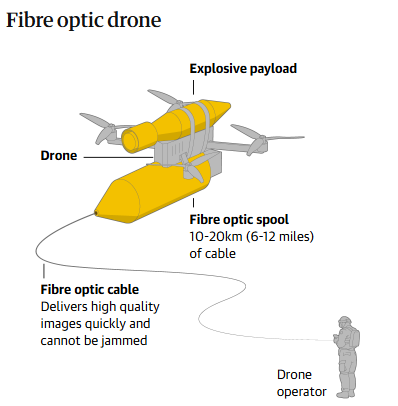
The proliferation of fibre optic drones in Ukraine gives a great glimpse of what we need to be ready for in large scale combat operations. ⬇️
No doubt you’ve heard of first person view (FPV) drones – small, cheap and fast drones controlled remotely by a pilot flying from real time vision. These were everywhere – Ukraine had the edge, Russia was racing to catch up. Physical and electronic counter measures were developed and soon jamming devices proliferated the front line.
Russia then seize the initiative with what at first may seem to be a backwards step – drones on a wire or fibre-optic drones have proliferated the battlefield. As The Washington Post reports they have proven to be a handy weapon with clear advantages over FPV drones:
“Fiber-optic drones, however, receive their signals from the cable that unspools as the device flies, and the only way to stop such a drone is to shoot it out of the sky. The cable greatly improves image quality and allows pilots to navigate more-complicated landscapes without losing their connection. They are also able to fly closer to the ground, making it easier to sneak up on enemy troops and perform more-complicated manoeuvres, although certain sharp turns can be hampered by the cable. Longer battery life means they can spend more time waiting for a target.”
Russia’s industrial base has rapidly scaled manufacturing and frontline troops have adapted to the nuances of flying by wire rather than by remote. Now Ukraine is innovating and developing fibre optic drones of their own, as well as countermeasures that will eventually reduce the effectiveness of the Russian tactics, techniques and procedures. This is the way of war – wonder weapons fade as your opponent is able to absorb the punches and adapt with innovations of their own.
For now, Russia has the advantage as it has scaled its ability to manufacture fibre optic spools at scale. Fibre optic drones cost roughly twice the cost of FPV drones so attacks often target defensive electronic warfare as expert Sam Bendett tells the Guardian:
“Since these drones cannot be jammed by electronic warfare, they’re used as a first wave of attack to target adversarial electronic warfare and jamming capability. That then clears the way for regular radio-controlled FPV drones to strike.”
Good, not great is what you need in large scale combat operations. In a war where the industrial might of nations is pitted against each other for years, weapons and equipment need to be easy to manufacture, use, repair and replace. Forget the exquisite – effective and efficient at scale is what you need.
Food for thought!
🖼️ via The Guardian and links to the Washington Post and the Guardian articles are in the comments.
